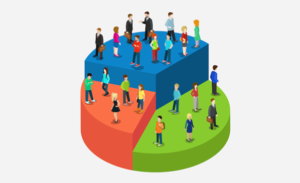We’ve been thinking about what ‘digital’ really means.
It’s a word that is variously used to describe tools, channels, people and ways of thinking.
So what does digital really encompass, and what is the true breadth of digital topics that relate to investment management firms?
It’s a mindset.
We often hear phrases like ‘not very digital’ or ‘we need digital thinking’.
Firstly, from our experience, much of the time this mindset needs to start at the top with the C-suite. The challenge can be separating digital marketing responsibilities from digital transformation. Often, the digital marketing leader becomes responsible for helping the organisation transform digitally. Although this varies based on the size of the organisation, we generally believe there need to be two separate functions, with the internal digital transformation of the firm being undertaken by one team, while the digital marketing team is left free to focus on the experiences of prospects and clients moving through the customer journey.
So how do we change the mindset of the C-suite, so that they understand the digital transformation that is taking place?
- Mapping customer journeys and understanding the data that tells us what channels prospects and clients are using.
- Research that shows how experiences are changing, both inside and outside our industry.
- Workshops that offer a hands-on, in-person approach to understanding the digital tools, processes and experiences that are available.
- Cross-functional teams collaborating to understand how we build experiences across the firm.
The specific process of transforming firms digitally can be the subject of another article at another time.
A second element of the digital mindset is creating a collaborative approach across sales and marketing, and client services in particular. By mapping customer journeys and understanding the ways that prospects and clients work across multiple channels and touch-points, we can understand how teams both can and should collaborate.
Part of this is ensuring that teams establish a common set of tools and processes, so that the experience is seamless through awareness, engagement, conversion and retention.
But most important is that each team recognises the purposes and capabilities of the other teams, to minimise redundancy and help keep the experience seamless.
What follows is the need for learning, across marketing teams in particular. Successful digital marketing requires an increasingly complex set of tools, as well as the skills required to use them. Some of this can be managed through the most effective structure for marketing teams: centralised specialists and devolved channel or segment marketers. There is also the simple need for all marketers to be upskilled in the basics of digital marketing, so they understand the underlying tools, data and insights.
Finally, thinking in an agile manner falls under the banner of mindset. Agile is a philosophy rooted in software development and not limited to digital, but it is a way of thinking that is relevant to marketing teams.
Some of the principles of agile are powerful when it comes to contemplating always-on marketing, involving backlogs, prioritisation and a sprint methodology. This enables you to get your proposition or product in front of customers or users as soon as possible, and in return to learn from it and build on it.
It's an experience.
Our approach to digital has always been strongly rooted in information architecture and user experience.
Digital has led the way in considering the user experience across channels – not just digital – and we're seeing that now playing out in the current, overdue focus on customer experience and journeys. This focus should help ensure that the brand experience is implemented consistently across all channels and touch-points.
One key learning is ensuring that user experience is not limited to new website builds, but is an ongoing consideration that informs all new content that’s built for websites. Similarly, UX should be implemented across the complete customer journey – whether that's email, website content search or social journeys.
UX – and really digital design or UI – is a discipline that is less subjective than perhaps we think, and it should definitely be left to the experts.

It's about growth.
This is perhaps the loosest interpretation of digital, but it is often the main element of how we grow business through legitimate lead generation, marketing automation and conversions.
Firms with a growth mindset are thinking about how they segment their prospects and existing clients in their CRM.
They are thinking about how to build campaigns that generate leads and guide prospects and clients through automated journeys, which also lay the groundwork for integrating AI into their marketing activities.
In particular, firms are blending their social media strategies with their content production and marketing automation plans to create customer journeys that span the full funnel and result in more effective conversions.
It's innovation.
The term digital suggests innovation, and we see, for example, marketing automation as the foundation of the integration of AI. This relies on ensuring that your client data, segmentation, measurement, content and email automation tools are set up correctly, and can form the basis of how you might start using AI to automate, scale and personalise interactions.
As well as the AI element, innovation overlaps with thinking about operating models and your marketing technology architecture.

It's technology.
Underpinning digital is the need for a marketing technology stack that provides support across the funnel, and from the front-end experiences to the back-end content and data in terms of governance.
We are big fans of technology that is open and connected, allowing the delivery of content and data from single sources across multiple channels and interfaces.
This is intertwined with operating models where the structure of people, processes and technology is visualised to best support global, regional and localised marketing and sales.
A marketing technology platform should consider all the front-end tools across paid and organic social and email, through to the CRM, CMS, marketing automation platforms and data storage. It should also extend to workflows, and the infrastructure for speed and security.
In conclusion.
Digital is a widely used phrase with multiple meanings, most of which are reasonable. However, it’s scope means that a wide range of expertise and resources are required to plan, build and deliver in this area.